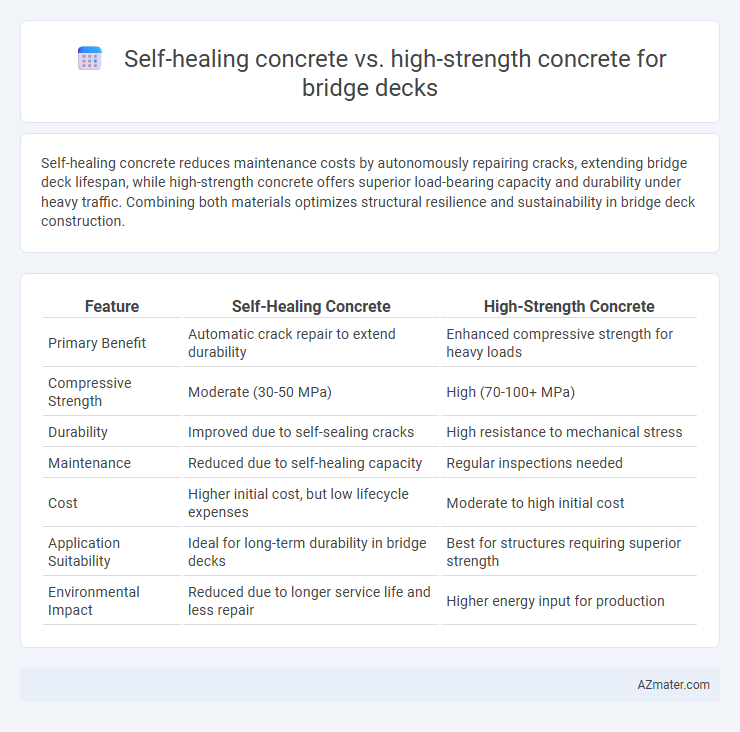Self-healing concrete reduces maintenance costs by autonomously repairing cracks, extending bridge deck lifespan, while high-strength concrete offers superior load-bearing capacity and durability under heavy traffic. Combining both materials optimizes structural resilience and sustainability in bridge deck construction.
Table of Comparison
| Feature | Self-Healing Concrete | High-Strength Concrete |
|---|---|---|
| Primary Benefit | Automatic crack repair to extend durability | Enhanced compressive strength for heavy loads |
| Compressive Strength | Moderate (30-50 MPa) | High (70-100+ MPa) |
| Durability | Improved due to self-sealing cracks | High resistance to mechanical stress |
| Maintenance | Reduced due to self-healing capacity | Regular inspections needed |
| Cost | Higher initial cost, but low lifecycle expenses | Moderate to high initial cost |
| Application Suitability | Ideal for long-term durability in bridge decks | Best for structures requiring superior strength |
| Environmental Impact | Reduced due to longer service life and less repair | Higher energy input for production |
Introduction to Bridge Deck Materials
Bridge deck materials are critical for ensuring durability, load capacity, and longevity of infrastructure, with self-healing concrete and high-strength concrete representing two advanced options. Self-healing concrete incorporates microcapsules or bacteria to autonomously repair microcracks, reducing maintenance and extending service life, whereas high-strength concrete provides superior compressive strength and resistance to heavy traffic loads. Selection between these materials depends on factors such as environmental exposure, expected load conditions, and lifecycle cost analysis for optimal bridge deck performance.
Understanding Self-Healing Concrete
Self-healing concrete for bridge decks incorporates encapsulated healing agents or bacteria that activate upon crack formation, autonomously repairing microcracks to extend structural lifespan and reduce maintenance costs. High-strength concrete, characterized by its increased compressive strength, offers enhanced load-bearing capacity but lacks the intrinsic crack-repair mechanism of self-healing varieties. Understanding self-healing concrete involves recognizing its potential to improve durability and resilience by mitigating microcrack propagation, crucial for sustainable bridge deck performance.
Characteristics of High-Strength Concrete
High-strength concrete (HSC) for bridge decks is characterized by its compressive strength typically exceeding 6,000 psi (41 MPa), which allows for thinner slabs and longer spans without compromising structural integrity. Its dense microstructure improves durability by reducing permeability, enhancing resistance to freeze-thaw cycles, chemical attack, and abrasion common in bridge environments. HSC also exhibits excellent mechanical properties such as higher modulus of elasticity and improved fatigue resistance, making it a preferred choice for heavy-load and high-traffic bridge deck applications.
Durability Comparison: Self-Healing vs High-Strength Concrete
Self-healing concrete enhances durability by autonomously repairing micro-cracks through embedded healing agents, significantly reducing water ingress and chloride penetration that cause corrosion in bridge decks. High-strength concrete provides superior compressive strength and resistance to mechanical stresses but remains vulnerable to micro-crack propagation and environmental degradation without self-repair capabilities. Durability assessments show self-healing concrete extends service life and lowers maintenance costs compared to traditional high-strength concrete in harsh bridge deck environments.
Crack Resistance and Longevity
Self-healing concrete exhibits superior crack resistance for bridge decks by autonomously repairing microcracks through embedded healing agents, significantly reducing maintenance costs. High-strength concrete offers enhanced compressive strength up to 100 MPa, providing durability under heavy traffic loads but remains vulnerable to crack propagation without repair mechanisms. The longevity of self-healing concrete can extend bridge service life by 20-30% compared to conventional high-strength concrete due to its proactive crack management, optimizing structural integrity over time.
Maintenance and Lifecycle Costs
Self-healing concrete significantly reduces maintenance frequency and costs by autonomously repairing microcracks, extending the lifespan of bridge decks and minimizing the need for costly interventions. High-strength concrete offers superior durability and load-bearing capacity but typically requires more frequent maintenance due to vulnerability to cracks and environmental damage. Lifecycle cost analysis favors self-healing concrete for bridge decks as it lowers long-term expenses, enhances durability, and reduces the overall total cost of ownership compared to conventional high-strength concrete.
Environmental Impact and Sustainability
Self-healing concrete reduces maintenance costs and extends bridge deck lifespan by autonomously repairing micro-cracks, significantly decreasing resource consumption and carbon emissions compared to traditional materials. High-strength concrete offers superior load-bearing capacity and durability but often requires higher cement content, leading to increased CO2 emissions during production. Integrating self-healing technology in high-strength concrete formulations can enhance sustainability by minimizing environmental impact while maintaining structural performance for bridge decks.
Performance in Harsh Weather Conditions
Self-healing concrete significantly outperforms high-strength concrete in harsh weather conditions by autonomously repairing micro-cracks caused by freeze-thaw cycles and salt exposure, thereby extending the durability and lifespan of bridge decks. High-strength concrete offers superior load-bearing capacity but lacks intrinsic crack repair mechanisms, making it more susceptible to deterioration under fluctuating temperature and moisture conditions. Incorporating self-healing technology reduces maintenance frequency and lifecycle costs for bridge decks subjected to extreme weather environments.
Implementation Challenges and Limitations
Self-healing concrete enhances crack repair in bridge decks through microbial or chemical agents, but faces implementation challenges such as high costs, limited long-term durability data, and complex manufacturing processes. High-strength concrete offers superior load-bearing capacity and durability yet presents limitations including increased brittleness, susceptibility to shrinkage cracking, and difficulties in achieving uniform curing on large-scale bridge decks. Both materials require specialized construction techniques and quality control measures, making extensive field testing essential to address these constraints before widespread adoption.
Conclusion: Choosing the Best Concrete for Bridge Decks
Self-healing concrete offers significant advantages in durability and maintenance reduction for bridge decks by autonomously repairing micro-cracks, thereby extending service life and lowering life cycle costs. High-strength concrete provides superior load-bearing capacity and structural integrity, making it suitable for heavy traffic and high-stress environments. Selecting the best concrete depends on project priorities: prioritize self-healing concrete for longevity and sustainability, or high-strength concrete for immediate structural performance and heavy load resistance.

Infographic: Self-healing concrete vs High-strength concrete for Bridge deck
 azmater.com
azmater.com